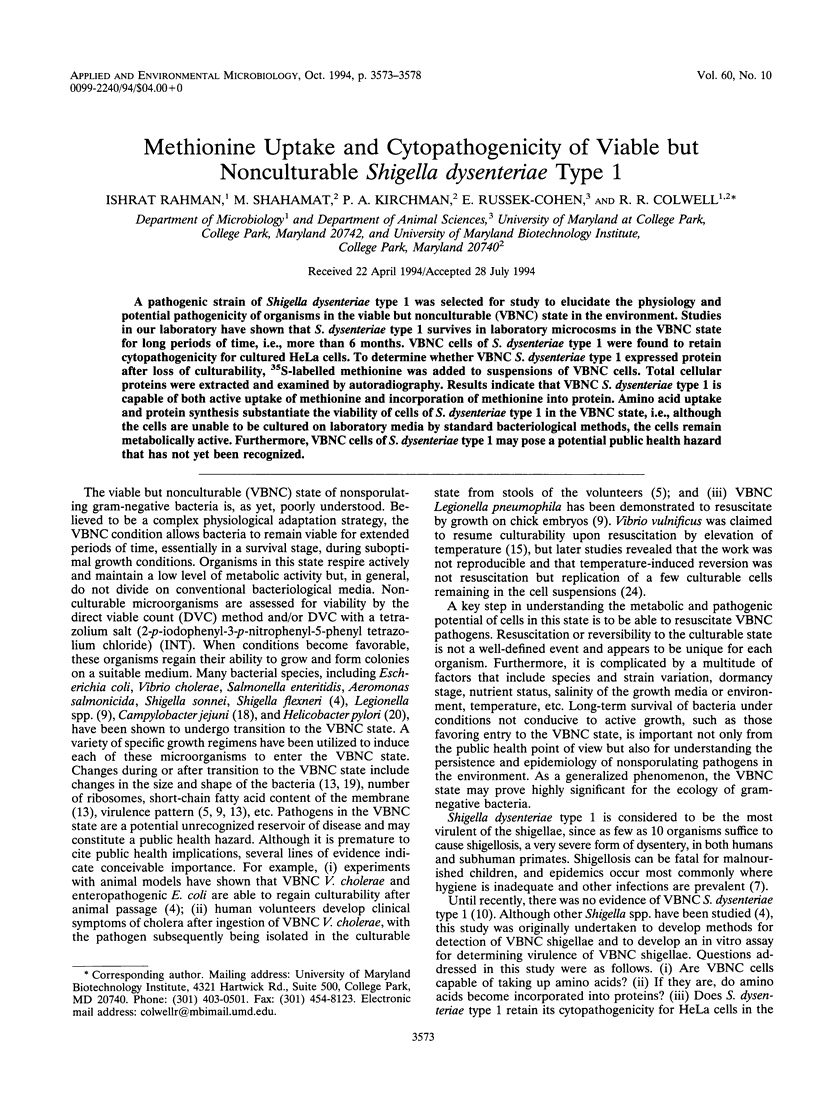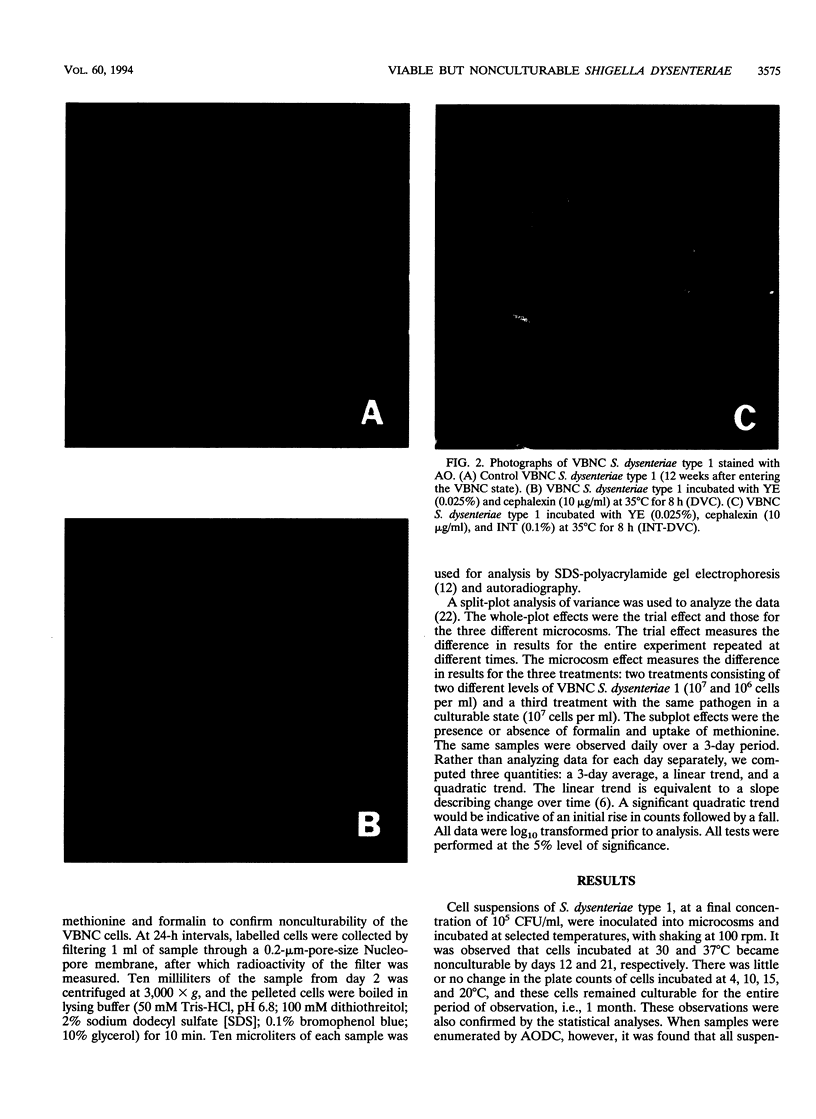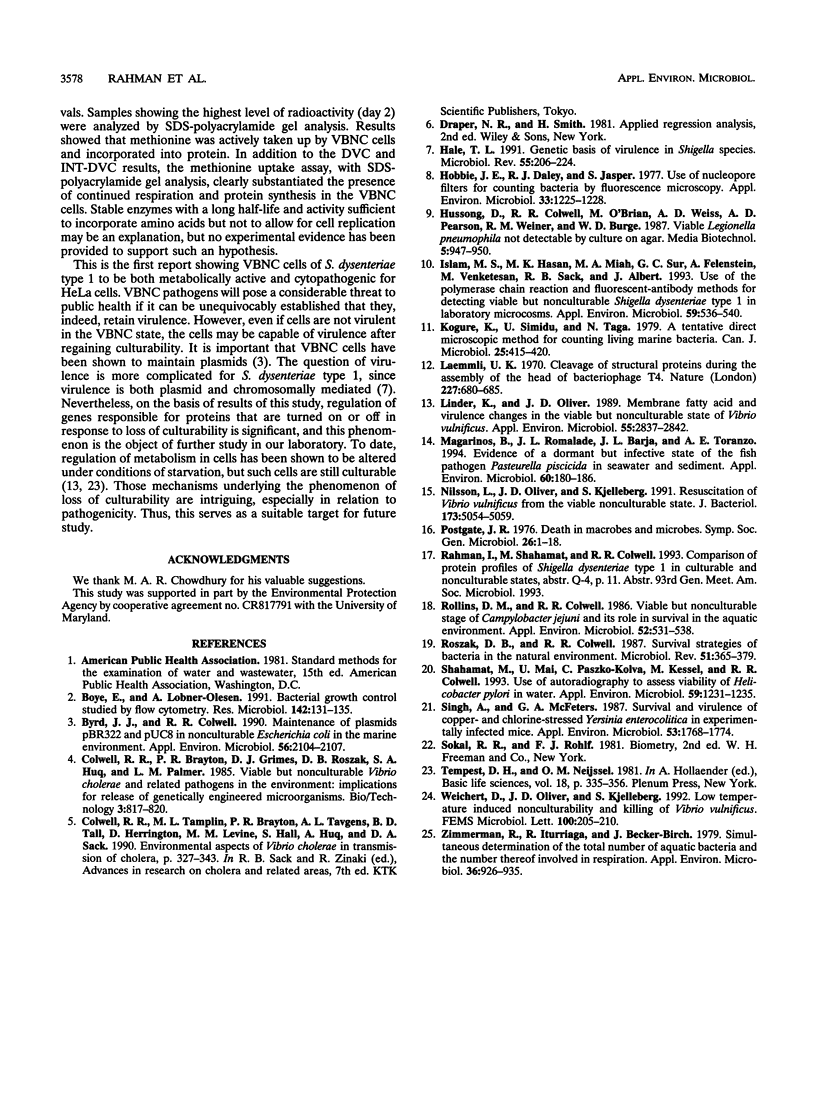Abstract
A pathogenic strain of Shigella dysenteriae type 1 was selected for study to elucidate the physiology and potential pathogenicity of organisms in the viable but nonculturable (VBNC) state in the environment. Studies in our laboratory have shown that S. dysenteriae type 1 survives in laboratory microcosms in the VBNC state for long periods of time, i.e., more than 6 months. VBNC cells of S. dysenteriae type 1 were found to retain cytopathogenicity for cultured HeLa cells. To determine whether VBNC S. dysenteriae type 1 expressed protein after loss of culturability, 35S-labelled methionine was added to suspensions of VBNC cells. Total cellular proteins were extracted and examined by autoradiography. Results indicate that VBNC S. dysenteriae type 1 is capable of both active uptake of methionine and incorporation of methionine into protein. Amino acid uptake and protein synthesis substantiate the viability of cells of S. dysenteriae type 1 in the VBNC state, i.e., although the cells are unable to be cultured on laboratory media by standard bacteriological methods, the cells remain metabolically active. Furthermore, VBNC cells of S. dysenteriae type 1 may pose a potential public health hazard that has not yet been recognized.
Full text
PDF





Images in this article
Selected References
These references are in PubMed. This may not be the complete list of references from this article.
- Boye E., Løbner-Olesen A. Bacterial growth control studied by flow cytometry. Res Microbiol. 1991 Feb-Apr;142(2-3):131–135. doi: 10.1016/0923-2508(91)90020-b. [DOI] [PubMed] [Google Scholar]
- Byrd J. J., Colwell R. R. Maintenance of plasmids pBR322 and pUC8 in nonculturable Escherichia coli in the marine environment. Appl Environ Microbiol. 1990 Jul;56(7):2104–2107. doi: 10.1128/aem.56.7.2104-2107.1990. [DOI] [PMC free article] [PubMed] [Google Scholar]
- Hale T. L. Genetic basis of virulence in Shigella species. Microbiol Rev. 1991 Jun;55(2):206–224. doi: 10.1128/mr.55.2.206-224.1991. [DOI] [PMC free article] [PubMed] [Google Scholar]
- Hobbie J. E., Daley R. J., Jasper S. Use of nuclepore filters for counting bacteria by fluorescence microscopy. Appl Environ Microbiol. 1977 May;33(5):1225–1228. doi: 10.1128/aem.33.5.1225-1228.1977. [DOI] [PMC free article] [PubMed] [Google Scholar]
- Islam M. S., Hasan M. K., Miah M. A., Sur G. C., Felsenstein A., Venkatesan M., Sack R. B., Albert M. J. Use of the polymerase chain reaction and fluorescent-antibody methods for detecting viable but nonculturable Shigella dysenteriae type 1 in laboratory microcosms. Appl Environ Microbiol. 1993 Feb;59(2):536–540. doi: 10.1128/aem.59.2.536-540.1993. [DOI] [PMC free article] [PubMed] [Google Scholar]
- Kogure K., Simidu U., Taga N. A tentative direct microscopic method for counting living marine bacteria. Can J Microbiol. 1979 Mar;25(3):415–420. doi: 10.1139/m79-063. [DOI] [PubMed] [Google Scholar]
- Laemmli U. K. Cleavage of structural proteins during the assembly of the head of bacteriophage T4. Nature. 1970 Aug 15;227(5259):680–685. doi: 10.1038/227680a0. [DOI] [PubMed] [Google Scholar]
- Linder K., Oliver J. D. Membrane fatty acid and virulence changes in the viable but nonculturable state of Vibrio vulnificus. Appl Environ Microbiol. 1989 Nov;55(11):2837–2842. doi: 10.1128/aem.55.11.2837-2842.1989. [DOI] [PMC free article] [PubMed] [Google Scholar]
- Magariños B., Romalde J. L., Barja J. L., Toranzo A. E. Evidence of a dormant but infective state of the fish pathogen Pasteurella piscicida in seawater and sediment. Appl Environ Microbiol. 1994 Jan;60(1):180–186. doi: 10.1128/aem.60.1.180-186.1994. [DOI] [PMC free article] [PubMed] [Google Scholar]
- Nilsson L., Oliver J. D., Kjelleberg S. Resuscitation of Vibrio vulnificus from the viable but nonculturable state. J Bacteriol. 1991 Aug;173(16):5054–5059. doi: 10.1128/jb.173.16.5054-5059.1991. [DOI] [PMC free article] [PubMed] [Google Scholar]
- Rollins D. M., Colwell R. R. Viable but nonculturable stage of Campylobacter jejuni and its role in survival in the natural aquatic environment. Appl Environ Microbiol. 1986 Sep;52(3):531–538. doi: 10.1128/aem.52.3.531-538.1986. [DOI] [PMC free article] [PubMed] [Google Scholar]
- Roszak D. B., Colwell R. R. Survival strategies of bacteria in the natural environment. Microbiol Rev. 1987 Sep;51(3):365–379. doi: 10.1128/mr.51.3.365-379.1987. [DOI] [PMC free article] [PubMed] [Google Scholar]
- Shahamat M., Mai U., Paszko-Kolva C., Kessel M., Colwell R. R. Use of autoradiography to assess viability of Helicobacter pylori in water. Appl Environ Microbiol. 1993 Apr;59(4):1231–1235. doi: 10.1128/aem.59.4.1231-1235.1993. [DOI] [PMC free article] [PubMed] [Google Scholar]
- Singh A., McFeters G. A. Survival and virulence of copper- and chlorine-stressed Yersinia enterocolitica in experimentally infected mice. Appl Environ Microbiol. 1987 Aug;53(8):1768–1774. doi: 10.1128/aem.53.8.1768-1774.1987. [DOI] [PMC free article] [PubMed] [Google Scholar]
- Tempest D. W., Neijssel O. M. Metabolic compromises involved in the growth of microorganisms in nutrient-limited (chemostat) environments. Basic Life Sci. 1981;18:335–356. doi: 10.1007/978-1-4684-3980-9_20. [DOI] [PubMed] [Google Scholar]
- Weichart D., Oliver J. D., Kjelleberg S. Low temperature induced non-culturability and killing of Vibrio vulnificus. FEMS Microbiol Lett. 1992 Dec 15;100(1-3):205–210. doi: 10.1111/j.1574-6968.1992.tb14041.x. [DOI] [PubMed] [Google Scholar]
- Zimmermann R., Iturriaga R., Becker-Birck J. Simultaneous determination of the total number of aquatic bacteria and the number thereof involved in respiration. Appl Environ Microbiol. 1978 Dec;36(6):926–935. doi: 10.1128/aem.36.6.926-935.1978. [DOI] [PMC free article] [PubMed] [Google Scholar]





